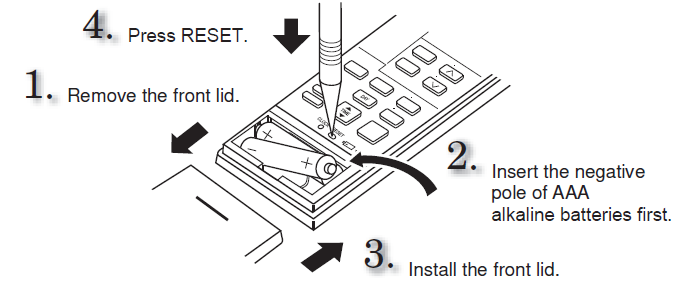Mitsubishi Electric Air Conditioner with Remote

SAFETY PRECAUTIONS
- Since rotating parts and parts which could cause an electric shock are used in this product, be sure to read these “Safety Precautions” before use.
- Since the cautionary items shown here are important for safety, be sure to observe them.
- After reading this manual, keep it together with the installation manual in a handy place for easy reference.
- Be sure to receive a guarantee card from your dealer and check that the purchased date and shop name, etc. are entered correctly.
- Do not connect the power cord to an intermediate point, use an extension cord, or connect multiple devices to a single AC outlet.
- This may cause overheating, fi re, or electric shock.
- Make sure the power plug is free of dirt and insert it securely into the outlet.
- A dirty plug may cause fi re or electric shock.
- Do not bundle, pull, damage, or modify the power cord, and do not apply heat or place heavy objects on it.
- This may cause fi re or electric shock.
- Do not turn the breaker OFF/ON or disconnect/connect the power plug during operation.
- This may create sparks, which can cause fi re.
- After the indoor unit is switched OFF with the remote controller, make sure to turn the breaker OFF or disconnect the power plug.
- Do not expose your body directly to cool air for a prolonged length of time.
- This could be detrimental to your health.
- The unit should not be installed, relocated, disassembled, altered, or repaired by the user.
- An improperly handled air conditioner may cause fi re, electric shock, injury, or water leakage, etc. Consult your dealer.
- If the power supply cord is damaged, it must be replaced by the manufacturer or its service agent in order to avoid a hazard.
- When installing, relocating, or servicing the unit, make sure that no substance other than the specified refrigerant (R32) enters the refrigerant circuit.
- Any presence of foreign substance such as air can cause abnormal pressure rise and may result in explosion or injury.
- The use of any refrigerant other than that specified for the system will cause mechanical failure, system malfunction, or unit breakdown. In the worst case, this could lead to a serious impediment to securing product safety.
- This appliance is not intended for use by persons (including children) with reduced physical, sensory or mental capabilities, or lack of experience and knowledge, unless they have been given supervision or instruction concerning use of the appliance by a person responsible for their safety.
- Children should be supervised to ensure that they do not play with the appliance.
- Do not insert your fi nger, a stick, or other objects into the air inlet or outlet.
- This may cause injury, since the fan inside rotates at high speeds during operation.
- In case of an abnormal condition (such as a burning smell), stop the air conditioner and disconnect the power plug or turn the breaker OFF.
- A continued operation in the abnormal state may cause a malfunction, fire, or electric shock. In this case, consult your dealer.
- The user should never attempt to wash the inside of the indoor unit. Should the inside of the unit require cleaning, contact your dealer.
- Unsuitable detergent may cause damage to plastic material inside the unit, which may result in water leakage. Should detergent come in contact with electrical parts or the motor, it will result in a malfunction, smoke, or fire.
- The appliance shall be stored in a room without continuously operating ignition sources (for example: open flames, an operating gas appliance or an operating electric heater).
- Be aware that refrigerants may not contain an odour.
- Do not use means to accelerate the defrosting process or to clean the appliance, other than those recommended by the manufacturer.
- Do not pierce or burn.
- Before cleaning the unit, switch it OFF and disconnect the power plug or turn the breaker OFF.
- This may cause injury, since the fan inside rotates at high speeds during operation.
- When the unit will be unused for a long time, disconnect the power plug or turn the breaker OFF.
- The unit may accumulate dirt, which may cause overheating or fire. Replace all batteries of the remote controller with new ones of the same type.
- Using an old battery together with a new one may cause overheating, leakage, or explosion.
- If the battery fluid comes in contact with your skin or clothes, wash them thoroughly with clean water.
- If the battery fluid comes in contact with your eyes, wash them thoroughly with clean water and immediately seek medical attention.
- Ensure that the area is well-ventilated when the unit is operated together with a combustion appliance.
- Inadequate ventilation may cause oxygen starvation.
- Turn the breaker OFF when you hear thunder and there is a possibility of a lightning strike.
- The unit may be damaged if lightning strikes.
- After the air conditioner is used for several seasons, perform inspection and maintenance in addition to normal cleaning.
- Dirt or dust in the unit may create an unpleasant odor, contribute to growth of fungi, such as mold, or clog the drain passage, and cause water to leak from the indoor unit. Consult your dealer for inspection and maintenance, which require specialized knowledge and skills
- Do not operate switches with wet hands.
- This may cause electric shock.
- Do not clean the air conditioner with water or place an object that contains water, such as a flower vase, on it.
- This may cause fi re or electric shock.
- Do not step on or place any object on the outdoor unit.
- This may cause injury if you or the object falls down.
CAUTION:
- Do not touch the air inlet or the aluminum fi ns of the indoor/outdoor unit.• This may cause injury.
- Do not use insecticides or flammable sprays on the unit.• This may cause a fi re or deformation of the unit.
- Do not expose pets or houseplants to direct airflow.• This may cause injury to the pets or plants.
- Do not place other electric appliances or furniture under the indoor/ outdoor unit.• Water may drip down from the unit, which may cause damage or malfunction.
- Do not leave the unit on a damaged installation stand.• The unit may fall and cause injury.
- Do not step on an unstable bench to operate or clean the unit.• This may cause injury if you fall down.
- Do not pull the power cord.• This may cause a portion of the core wire to break, which may cause overheating or fire.
- Do not charge or disassemble the batteries, and do not throw them into a fire.• This may cause the batteries to leak, or cause a fi re or explosion.
- Do not operate the unit for more than 4 hours at high humidity (80% RH or more) and/or with windows or outside door left open.• This may cause the water condensation in the air conditioner, which may drip down, wetting or damaging the furniture.• The water condensation in the air conditioner may contribute to growth of fungi, such as mold.
- Do not use the unit for special purposes, such as storing food, raising animals, growing plants, or preserving precision devices or art objects.• This may cause deterioration of quality, or harm to animals and plants.
- Do not expose combustion appliances to direct airflow.• This may cause incomplete combustion.
- Never put batteries in your mouth for any reason to avoid accidental ingestion.• Battery ingestion may cause choking and/or poisoning.
For installation
- Consult your dealer for installing the air conditioner.• It should not be installed by the user since installation requires specialized knowledge and skills. An improperly installed air conditioner may cause water leakage, fire, or electric shock.
- Provide a dedicated power supply for the air conditioner.• A non-dedicated power supply may cause overheating or fire.
- Do not install the unit where flammable gas could leak.• If gas leaks and accumulates around the outdoor unit, it may cause an explosion.
- Earth the unit correctly.• Do not connect the earth wire to a gas pipe, water pipe, lightning rod, or a telephone earth wire. Improper earthing may cause electric shock.
- Install an earth leakage breaker depending on the installation location of the air conditioner (such as highly humid areas).• If an earth leakage breaker is not installed, it may cause electric shock.
- Ensure that the drain water is properly drained.• If the drain passage is improper, water may drip down from the indoor/ outdoor unit, wetting and damaging the furniture.
For Wi-Fi interface
This appliance can be used by children aged from 8 years and above and persons with reduced physical, sensory or mental capabilities or lack of experience and knowledge if they have been given supervision or instruction concerning use of the appliance in a safe way and understand the hazards involved.
Children shall not play with the appliance. Cleaning and user maintenance shall not be made by children without supervision.
- Do not use the Wi-Fi interface nearby the medical electrical equipment or people who have a medical device such as a cardiac pacemaker or an implantable cardioverter-defi brillator.• It can cause an accident due to malfunctions of the medical equipment or device.
- Do not install the Wi-Fi interface nearby the automatic control devices such as automatic doors or fi re alarms.• It can cause accidents due to malfunctions.
- Do not touch the Wi-Fi interface with wet hands.• It can cause damage to the device, electric shock, or fi re.
- Do not splash water on the Wi-Fi interface or use it in a bathroom.• It can cause damage to the device, electric shock, or fi re.
- When the Wi-Fi interface is dropped, or the holder or cable is damaged, disconnect the power supply plug or turn the breaker OFF.• It may cause fi re or electric shock. In this case, consult your dealer.• This device complies with all Australia and New zealand regulrements for EMC and electrical safety.
- Do not step on unstable stepstool to set up or clean the Wi-Fi interface.• It may cause injury if you fall down.
- Do not use the Wi-Fi interface nearby other wireless devices, microwaves, cordless phones, or facsimiles.• It can cause malfunctions.
Indoor unit
Outdoor unit
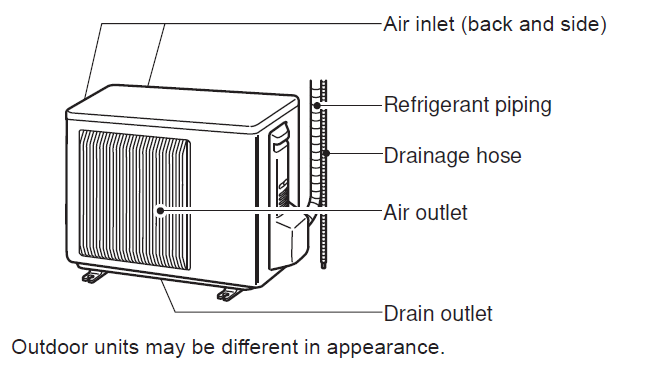
Remote controller
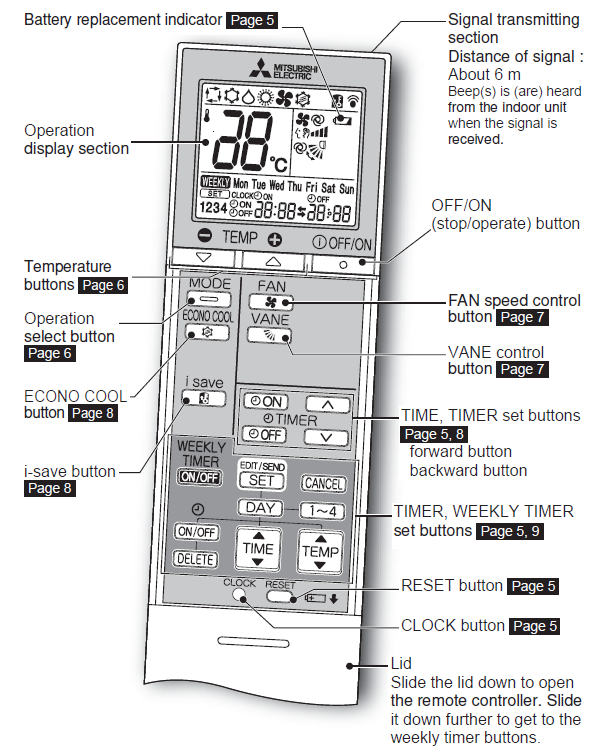
Only use the remote controller provided with the unit.Do not use other remote controllers. If 2 or more indoor units are installed in proximity to one another, an indoor unit that is not intended to be operated may respond to the remote controller.
Remote controller holder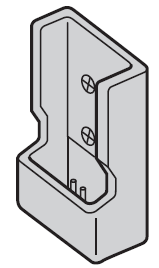
PREPARATION BEFORE OPERATION
Installing the remote controller batteries
Note:
- Make sure the polarity of the batteries is correct.
- Do not use manganese batteries and leaking batteries. The remote controller could malfunction.
- Do not use rechargeable batteries.
- The battery replacement indicator lights up when the battery is running low.In about 7 days after the indicator starts lights up, the remote controller stops working.
- Replace all batteries with new ones of the same type.
- Batteries can be used for approximately 1 year. However, batteries with expired shelf lives last shorter.
- Press RESET gently using a thin instrument. If the RESET button is not pressed, the remote controller may not operate correctly.
Setting current time
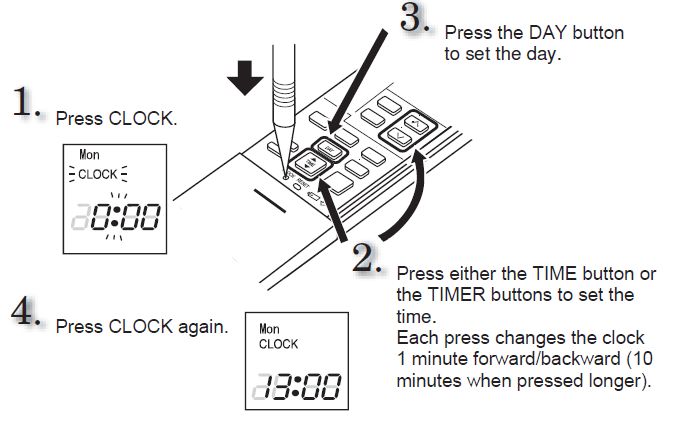
Note:How to set remote controller exclusively for a particular indoor unit
A maximum of 4 indoor units with wireless remote controllers can be used in a room.To operate the indoor units individually with each remote controller, assign a number to each remote controller according to the number of the indoor unit.
This setting can be set only when all the following conditions are met:
• The remote controller is powered OFF.
- Hold down button on the remote controller for 2 seconds to enter the pairing mode.
- Press button again and assign a number to each remote controller.Each press of button advances the number in the following order: 1 → 2 → 3 → 4.
- Press button to complete the pairing setting.After you turn the breaker ON, the remote controller that first sends a signal to an indoor unit will be regarded as the remote controller for the indoor unit.
Once they are set, the indoor unit will only receive the signal from the assigned remote controller afterwards.
SELECTING OPERATION MODES
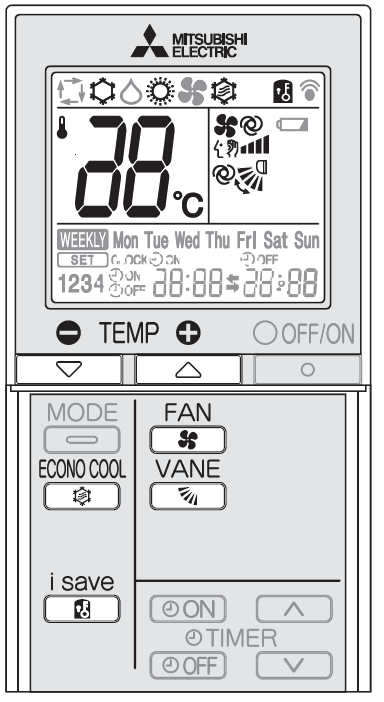
Press to select operation mode. Each press changes mode in the following order:

AUTO mode (Auto change over)
The unit selects the operation mode according to the difference between the room temperature and the set temperature. During AUTO mode, the unit changes mode (COOL↔HEAT) when the room temperature is about 2°C away from the set temperature for more than 15 minutes.
Note: Auto Mode is not recommended if this indoor unit is connected to a MXZ type outdoor unit. When several indoor units are operated simultaneously, the unit may not be able to switch operation mode between COOL and HEAT. In this case, the indoor unit becomes standby mode (Refer to table of Operation indicator lamp).
COOL mode
Enjoy cool air at your desired temperature.Note: Do not operate COOL mode at very low outside temperatures (less than -10°C). Water condensed in the unit may drip and wet or damage furniture, etc.
DRY mode
Dehumidify your room. The room may be cooled slightly.Temperature cannot be set during DRY mode.
HEAT mode
Enjoy warm air at your desired temperature.
FAN mode
Circulate the air in your room.
Note: After COOL/DRY mode operation, it is recommended to operate in the FAN mode to dry inside the indoor unit.
Operation indicator lamp
The operation indicator lamp shows the operation state of the unit.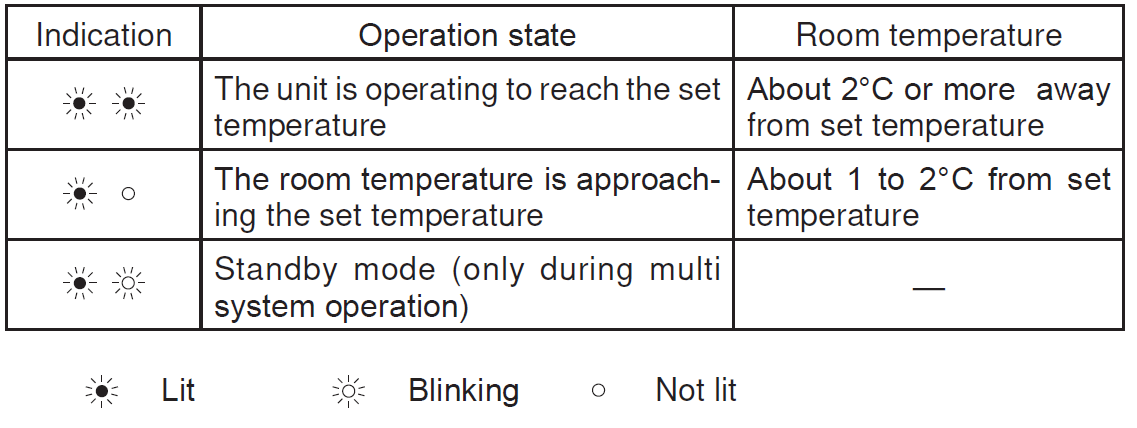

FAN SPEED AND AIRFLOW DIRECTION ADJUSTMENT
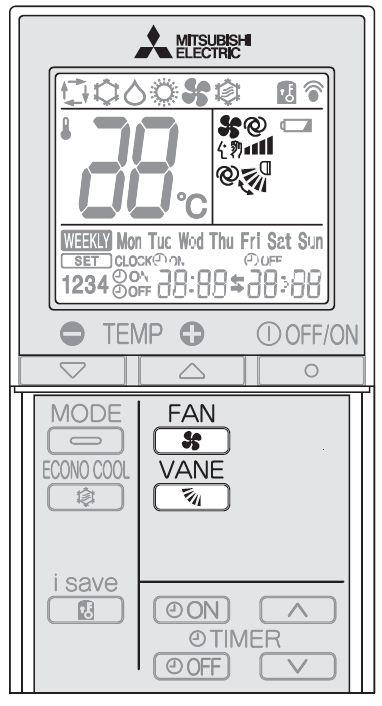

Fan speed
Press to select fan speed. Each press changes fan speed in the following order:

- Two short beeps are heard from the indoor unit when set to AUTO.
- Use higher fan speed to cool/heat the room quicker. It is recommended to lower the fan speed once the room is cool/warm.
- Use lower fan speed for quiet operation.
Multi system operationWhen several indoor units are operated simultaneously by one outdoor unit for heating operation, the temperature of the airfl ow may be low. In this case, it is recommended to set the fan speed to AUTO.
Up-down Airflow direction
Press to select airflow direction. Each press changes airflow direction in the following order:

(AUTO) ………The vane is set to the most effi cient airfl ow direction. COOL/DRY/FAN:horizontal position. HEAT:position (4).(Manual) …….For efficient air conditioning, select the upper position for COOL/DRY, and the lower position for HEAT. If the lower position is selected during COOL/DRY, the vane automatically moves to the upward position after 0.5 to 1 hour to prevent any condensation from dripping.(Swing) ………The vane moves up a nd down intermittently.
- Two short beeps are heard from the indoor unit when set to AUTO.
- Always use the remote controller when changing the direction of airflow. Moving the horizontal vanes with your hands causes them to malfunction.
- When the breaker is turned on, the horizontal vanes’ position will be reset in about a minute, then the operation will start. The same is true in the emergency cooling operation.
- When the horizontal vanes seem to be in an abnormal position,
Left-right Airflow direction
To change the horizontal airflow direction.Move the vertical vane manually before starting operation.
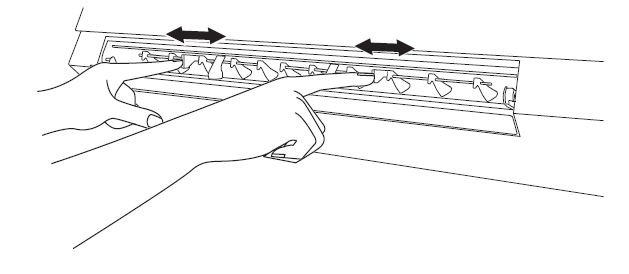

Note: If the vertical vanes are adjusted, be sure to return the horizontal vanes to the original closed position.
I-SAVE OPERATION



- A simplified set back function enables to recall the preferred (preset) setting with a single push of the button. Press the button again and you can go back to the previous setting in an instance.
- i-save operation cannot be set on the weekly timer.
- Press during COOL, ECONO COOL, or HEAT mode to select i-save mode. Set the temperature, fan speed, and airflow direction.
- The same setting is selected from the next time by simply pressing
- Two settings can be saved. (One for COOL/ECONO COOL, one for HEAT)
- Select the appropriate temperature, fan speed, and airflow direction according to your room.
- Normally, the minimum temperature setting in HEAT mode is 16°C.
However, during i-save operation only, the minimum temperature setting is 10°C.
Note:Example of use:
- Low energy modeSet the temperature 2°C to 3°C warmer in COOL and cooler in HEAT mode. This setting is suitable for unoccupied room, and while you are sleeping.
- Saving frequently used settingsSave your preferred setting for COOL/ECONO COOL and HEAT. This enables you to select your preferred setting with a single push of the button.
ECONO COOL OPERATION


Swing airflow (change of air flow) makes you feel cooler than stationary airflow. The set temperature and the airflow direction are automatically changed by the microprocessor. It is possible to perform cooling operation with keeping comfort. As a result energy can be saved.
Wi-Fi INTERFACE SETTING UP (VGK TYPE ONLY)
Check the following fi rst in the cases listed in the above table.
- Make sure that the communication distance is not too far between the Wi-Fi interface and the Router.
- Make sure 2.4GHz is enabled on dual band Routers.
- Make sure that WPS is working on the Router.
- Make sure that the Router is compatible with the Wi-Fi interface.
- If Static IP has been set – make sure it is correct as per Router network settings.
- Make sure that the Router uses WPA2-PSK(AES) encryption.
- Make sure that the number of connected devices to the Router does not exceed the limit.
- Every 0.5 sec:IP address setting is invalid.Make sure that DHCP is enabled, or check IP address settings of the Wi-Fi interface.If there are no problems on the items above, but the lamp is still flashing, push RESET Button for more than 14 seconds to retry the pairing.
- Every second:DNS setting is invalid.FIX DNS setting of the Router, DNS address setting of the Wi-Fi interface, or import the ratio wave environment.If there are no problems on the items above, but the lamp is still flashing, push RESET Button for more than 14 seconds to retry the pairing.
- Once every 5 sec:Not communicating with server properly.Push RESET Button for 2 seconds.
- Twice every 5 sec:Not connected to server.Check if the Router is connected to the Internet.
- Three times every 5 sec:Not communicating with server. (Quick communication error)Push RESET Button for 2 seconds.
Note:
- Ensure that the Router supports the WPA2-PSK(AES) encryption setting before starting the Wi-Fi interface setup.
- The End user should read and accept the terms and conditions of the Wi-Fi service before using this Wi-Fi interface.
- To complete connection of this Wi-Fi interface to the Wi-Fi service, the Router may be required.
- This Wi-Fi interface will not commence transmission of any operational data from the system until the End user registers and accepts the terms and conditions of the Wi-Fi service.
- This Wi-Fi interface should not be installed and connected to any Mitsubishi Electric system which is to provide application critical cooling or heating.
- Please write down the information regarding the Wi-Fi interface setting on the last page of this manual, when you set up this Wi-Fi interface.
- At the time of relocation or disposal, reset the Wi-Fi interface to the factory default.
Mitsubishi Electric’s Wi-Fi interface is designed for communication to Mitsubishi Electric’s Wi-Fi service. Third party Wi-Fi interfaces cannot connect to Mitsubishi Electric’s Wi-Fi service. Mitsubishi Electric is not responsible for any
- underperformance of a system or any product;
- system or product fault; or
- loss or damage to any system or product; which is caused by or arises from connection to and/or use of any third party Wi-Fi interface or any third party Wi-Fi service with Mitsubishi Electric equipment.
WHEN YOU THINK THAT TROUBLE HAS OCCURRED
| Symptom | Explanation & Check points |
| Indoor Unit | |
| The unit cannot be operated. | • Is the breaker turned on?
• Is the power supply plug connected? • Is the ON timer set? Page 8 |
| The horizontal vane does not move. | • Are the horizontal vane and the vertical vane
installed correctly? • Is the fan guard deformed? • When the breaker is turned on, the horizontal vanes’ position will be reset in about a minute. After the reset has completed, the normal hori- zontal vanes’ operation resumes. The same is true in the emergency cooling operation. |
| The unit cannot be operated for
about 3 minutes when restarted. |
• This protects the unit according to instructions
from the microprocessor. Please wait. |
| Mist is discharged from the air
outlet of the indoor unit. |
• The cool air from the unit rapidly cools moisture in the air inside the room, and it turns into mist. |
| The swing operation of the HORI- ZONTAL VANE is suspended for a while, then restarted. | • This is for the swing operation of the HORIZON- TAL VANE to be performed normally. |
| When SWING is selected in COOL/DRY/FAN mode, the lower horizontal vane does not move. | • It is normal that the lower horizontal vane does not move when SWING is selected in COOL/ DRY/FAN mode. |
| The airflow direction changes
during operation. The direction of the horizontal vane cannot be adjusted with the remote controller. |
• When the unit is operated in COOL or DRY mode, if the operation continues with air blow- ing down for 0.5 to 1 hour, the direction of the airflow is automatically set to upward position to prevent water from condensing and dripping.
• In the heating operation, if the airflow tem- perature is too low or when defrosting is being done, the horizontal vane is automatically set to horizontal position. |
| The operation stops for about 10 minutes in the heating operation. | • Outdoor unit is in defrost.
Since this is completed in max. 10 minutes, please wait. (When the outside temperature is too low and humidity is too high, frost is formed.) |
| The unit starts operation by itself when the main power is turned on, but hasn’t received sign from the remote controller. | • These models are equipped with an auto restart function. When the main power is turned off without stopping the unit with the remote controller and is turned on again, the unit starts operation automatically in the same mode as the one set with the remote control- ler just before the shutoff of the main power.
Refer to “Auto restart function”. Page 10 |
| The two horizontal vanes touch each other. The horizontal vanes are in an abnormal posi- tion. The horizontal vanes do not return to the correct “close position”. | Perform one of the following:
• Turn off and on the breaker. Make sure the hori- zontal vanes move to the correct “close position”. • Start and stop the emergency cooling operation and make sure the horizontal vanes move to the correct “close position”. |
| The indoor unit discolors over time. | • Although plastic turns yellow due to the influence of some factors such as ultraviolet light and temperature, this has no effect on the product functions. |
| Multi system | |
| The indoor unit which is not operating becomes warm and a sound, similar to water flowing, is heard from the unit. | • A small amount of refrigerant continues to flow into the indoor unit even though it is not operat- ing. |
| When heating operation is selected, operation does not start right away. | • When operation is started during defrosting of outdoor unit is done, it takes a few minutes (max. 10 minutes) to blow out warm air. |
| Outdoor Unit | |
| The fan of the outdoor unit does not rotate even though the com- pressor is running. Even if the fan starts to rotate, it stops soon. | • When the outside temperature is low during cooling operation, the fan operates intermittently to maintain sufficient cooling capacity. |
| Water leaks from the outdoor
unit. |
• During COOL and DRY operations, pipe or pipe connecting sections are cooled and this causes water to condense.
• In the heating operation, water condensed on the heat exchanger drips down. • In the heating operation, the defrosting operation makes ice forming on the outdoor unit melt and drip down. |
| White smoke is discharged from
the outdoor unit. |
• In the heating operation, vapor generated by the
defrosting operation looks like white smoke. |
| Symptom | Explanation & Check points |
| Remote controller | |
| The display on the remote controller does not appear or it is dim. The indoor unit does not respond to the remote control signal. | • Are the batteries exhausted? Page 5
• Is the polarity (+, -) of the batteries correct? Page 5 • Are any buttons on the remote controller of other electric appliances being pressed? |
| Does not cool or heat | |
| The room cannot be cooled or
heated sufficiently. |
• Is the temperature setting appropriate?
Page 6 • Is the fan setting appropriate? Please change fan speed to High or Super High. Page 7 • Are the filters clean? Page 11 • Is the fan or heat exchanger of the indoor unit clean? • Are there any obstacles blocking the air inlet or outlet of the indoor or outdoor unit? • Is a window or door open? • It may take a certain time to reach the setting temperature or may not reach that depending on the size of the room, the ambient temperature, and the like. |
| The room cannot be cooled
sufficiently. |
• When a ventilation fan or a gas cooker is used in a room, the cooling load increases, resulting in an insufficient cooling effect.
• When the outside temperature is high, the cooling effect may not be sufficient. |
| The room cannot be heated
sufficiently. |
• When the outside temperature is low, the heating effect may not be sufficient. |
| Air does not blow out soon in
the heating operation. |
• Please wait as the unit is preparing to blow out warm air. |
| Airflow | |
| The air from the indoor unit smells strange. | • Are the filters clean? Page 11
• Is the fan or heat exchanger of the indoor unit clean? • The unit may suck in an odor adhering to the wall, carpet, furniture, cloth, etc. and blow it out with the air. |
| Sound | |
| Cracking sound is heard. | • This sound is generated by the expansion/con- traction of the front panel, etc. due to change in temperature. |
| “Burbling” sound is heard. | • This sound is heard when the outside air is absorbed from the drain hose by turning on the range hood or the ventilation fan, making water flowing in the drain hose to spout out.
This sound is also heard when the outside air blows into the drain hose in case the outside wind is strong. |
| Mechanical sound is heard
from the indoor unit. |
• This is the switching sound in turning on/off the
fan or the compressor. |
| The sound of water flowing is
heard. |
• This is the sound of refrigerant or condensed
water flowing in the unit. |
| Hissing sound is sometimes
heard. |
• This is the sound when the flow of refrigerant
inside the unit is changed. |
| Timer | |
| Weekly timer does not operate
according to settings. |
• Is the ON/OFF timer set? Page 8
• Transmit the setting information of the weekly timer to the indoor unit again. When the information is successfully received, a long beep will sound from the indoor unit. If information fails to be received, 3 short beeps will be heard. Ensure information is successfully received. Page 9 • When a power failure occurs and the main power turns off, the indoor unit built-in clock will be incorrect. As a result, the weekly timer may not work normally. Be sure to place the remote controller where the signal can be received by the indoor unit. Page 5 |
| The unit starts/stops the operation by itself. | • Is the weekly timer set? Page 9 |
SPECIFICATIONS
Guaranteed operating range
| Indoor | Outdoor | ||
|
Cooling |
Upper limit | 32°C DB
23°C WB |
46°C DB
— |
| Lower limit | 21°C DB
15°C WB |
-10°C DB
— |
|
|
Heating |
Upper limit | 27°C DB
— |
24°C DB
18°C WB |
| Lower limit | 20°C DB
— |
-15°C DB
-16°C WB |
DB : Dry Bulb WB : Wet Bulb
Wi-Fi interface
| Model | MAC-578IF2-E |
| Input Voltage | DC12.7 V (from indoor unit) |
| Power consumption | MAX. 2 W |
| Size H×W×D (mm) | 73.5×41.5×18.5 |
| Weight (g) | 46 (including cable) |
| Transmitter power level (MAX.) | 20 dBm @IEEE 802.11b |
| RF channel | 1ch ~ 13ch (2412~2472 MHz) |
| Radio protocol | IEEE 802.11b/g/n (20) |
| Encryption | AES |
| Authentication | WPA2-PSK |
| Software Version | XX.00 |
FAQ
It is a 220v unit. It will run on #12 wire and only requires a 15 amp breaker.
32 3/4 wide by 11 3/4 high measured against the wall. The blower unit is a little larger as it protrudes away from the wall.
Yes, it will be a great option for a shed. The 9,000 BTU covers an application area of up to 350 sq. ft.
Yes it does both heat and air. Great units
I’m not 100% clear on what you mean regarding a pad. If you are talking about the outdoor unit, it can sit on the ground/cement pad or be mounted on a wall. Hopefully that was the question.
I would check that your filters are clean, and that the drain line is not blocked and any condensation can drain from the inside unit. If all else fails, try cleaning the coils if they have gotten dirty
down to 5° F the system will work at 100% capacity
This specific one only has outside unit for just this 1 unit. There are others that can run several split units
It’s rated at 6.95 amps at 220 volts. You can look at the manufacturer’s spec sheet on the listing.
yes it needs at least 10 inches from the ceiling and yes over a window if you have the 10 inch clearance
VIDEO


References
[xyz-ips snippet=”download-snippet”]



